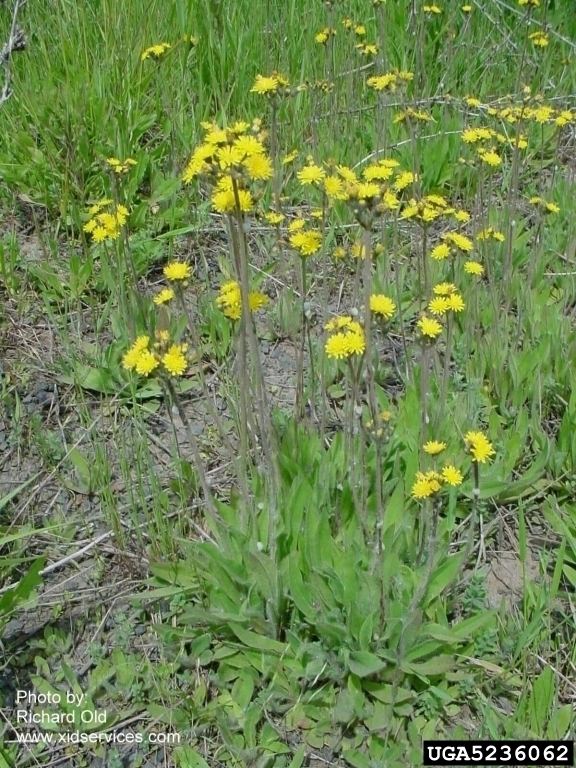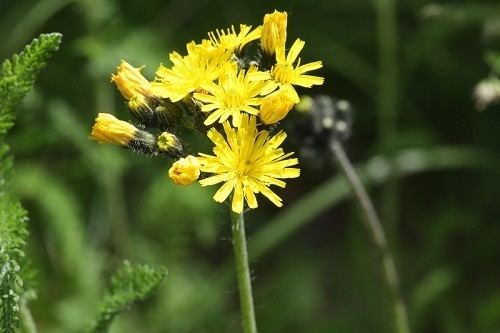Kingdom Plantae Genus Hieracium Higher classification Hieracium | Order Asterales Scientific name Hieracium caespitosum Rank Species | |
 | ||
Similar Hieracium, Daisy family, Pilosella aurantiaca, Hieracium laevigatum, Hieracium sabaudum | ||
Hieracium caespitosum (commonly known as meadow hawkweed, yellow hawkweed, field hawkweed, king devil, yellow paintbrush, devil's paintbrush, yellow devil, yellow fox-and-cubs, and yellow king-devil) is like several other Hieracium species and has a similar appearance to many of the other Hawkweeds.
Contents

Description
Hieracium caespitosum is a creeping perennial, with shallow, fibrous roots and long rhizomes.

The leaves, hairy on both sides (unlike Hieracium floribundum, which looks similar but has hair only on the underside), are up to 6 inches (15 centimeters) long, spathulate, and almost exclusively basal with the exception of 1 or 2 very small cauline leaves. The leaves lie flat to the ground, overlap, and will smother non-vigorous turf.

The stems are bristly and usually leafless, although occasionally a small leaf appears near the midpoint. Stems, leaves, and bracts have dense, blackish hairs and exude milky juice when broken.

The 1/2 inch (1 centimeter) flower heads appear in tight clusters at the top of the 1 to 3 foot (1/3 to 1 meter) stems with 5 to 40 flowers per cluster. Corollas are all ligulate and bright yellow. Each single flower head is an inflorescence and each petal forms its own seed, making them each a separate flower or floret.

The seeds are shiny, black, and plumed. After maturing they are dispersed by wind, clothing, hair, feathers, and some vehicles that disturb fields or soils. H. caespitosum persists and regrows each year from rhizomes and often spreads by stolons, which can be extensive, creating a dense mat of hawkweed plants (a colony) that practically eliminates other vegetation.
H. caespitosum prefers silt loam, well-drained soil: coarse textures, moderately low in organic matter, and moist. Its presence can be an indicator of low soil fertility or slightly acidic soils.
H. caespitosum has, in the past, been used for healing eyesight. Pliny the Elder had recorded information regarding how other species, specifically hawks, utilized H. caespitosum, specifically believing that they would eat it in an effort to improve eyesight.
Habitat and distribution
Tolerant of drought and trampling, this species finds its habitat where the soil has been neglected. Places like roadsides, neglected residential and commercial landscapes, minimally maintained public parks and open spaces, vacant lots, rubble dump sites, and abandoned grasslands (meadows).
H. caespitosum is an introduced species in North America and can be found in Canada (British Columbia, Manitoba, New Brunswick, Newfoundland, Labrador, Nova Scotia, Ontario, Prince Edward Island, and Quebec) and the United States (Connecticut, Washington D.C., Georgia, Idaho, Illinois, Indiana, Massachusetts, Maine, Michigan, Minnesota, Montana, North Carolina, New Hampshire, New Jersey, New York, Ohio, Oregon, Pennsylvania, Rhode Island, Tennessee, Virginia, Vermont, Washington, Wisconsin, West Virginia, and Wyoming). It is considered a noxious weed in Idaho, Montana, Oregon and Washington.
H. caespitosum's native range includes a large portion of Europe, including Austria, Belarus, Bulgaria, Czechoslovakia, Estonia, France, Finland, Germany, Greece, Hungary, Latvia, Lithuania, Norway, Poland, Romania, Sweden, Switzerland, Ukraine, and Yugoslavia.
